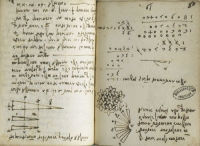Rule of Mathematics Click on the thumbnails to explore the trail
Read more about this trail (expand)
Leonardo believed that all things in nature were governed by mathematics. Mathematics was of supreme importance and expressed incontrovertible, universal truth. Knowledge of mathematics was a prerequisite for understanding the nature of all things. “Let no-one who is not a mathematician read my principles”, Leonardo said. Geometry and its actual or potential relationship to natural forms provided a suitably visual means for the exploration of mathematical “truths”.
Paris Manuscript L 1497-1502
As an accomplished musician, Leonardo was naturally interested in sound. To establish how sound travelled, he developed a “theory of perspective of sound”.
On sheet 80r, Leonardo illustrates his pyramidal law that the base of a triangle is proportional to its height. The base of the triangle here represents the volume of a sound and the apex the limit of its range. The upper triangle is divided into four sections, indicating that in half the distance, the volume is reduced by half. The smaller triangles illustrate how half the volume will travel half the distance. Similar diagrams were used by Leonardo to illustrate the action of gravity and the perception of size.
On the right sheet, seven radiating triangles represent seven voices of equal volume. The points of the triangles do not meet because multiple voices, however many, will not carry any further than a lone voice of equal volume. The seven star-shaped flowers immediately above may be an analogy with the sense of smell. Afterall, in order for the law to be truly universal, it should govern all the senses.
In Leonardo's words
Let proportion be found not only in numbers, but also in sounds, weights, times and positions, and whatever force there is.
This is an intact notebook compiled between the late 1490s and early 1500s. During this time Leonardo was in the employ of Cesare Borgia, commander of the Papal forces, as military architect and engineer.
The notes relate to Leonardo’s inspection of defensive fortifications and the masking of maps for Cesare. There are also important notes relating to the Last Supper.
The manuscript comprises of 94 folios.
- Medium Pen and ink on paper
- Size 10 x 7 cm
- Location Bibliothèque de l’Institut de France











